Home / Orbital Hybridization And Bond Strengths
Bonding, Structure, and Resonance
Orbital Hybridization And Bond Strengths
Last updated: December 29th, 2024 |
How Orbital Hybridization Affects Bond Strengths
Understanding the concept of hybrid orbitals (see previous post) lets you make accurate predictions about trends in bond strengths. In this post we’ll give several examples of how to do this.

Table of Contents
- A Quick Quiz (On Bond Dissociation Energy)
- Key Principle On Orbital Hybridization And Bond Strengths: The Greater The s-character, The Stronger The Bond
- Electrons In s-Orbitals Are Closer To the Nucleus Than Electrons In The Corresponding p-Orbitals
- Summary: All Else Being Equal, The Greater The s-Character, The Stronger The Bond
- Bonus Section: An Answer To A Question A Few People Might Be Asking
- Homolytic versus Heterolytic Bond Cleavage
- A Test For You
- One Last Thing: This Concept Also Explains Why CH3+ Is More Stable Than NH3+
- Notes
1. A Quick Quiz
Let’s start with a quick quiz.
What’s the strongest C–H bond, below?
(In other words, which C–H bond has the highest bond-dissociation energy?)

The answer is C.
- In a), the carbon is sp3 hybridized and the bond dissociation energy is 105 kcal/mol
- In b), the carbon is sp2 hybridized and the bond dissociation energy is 110 kcal/mol
- In c), the carbon is sp hybridized and the bond dissociation energy is 126 kcal/mol
2. Key Principle On Orbital Hybridization And Bond Strengths: The Greater The s-character, The Stronger The Bond
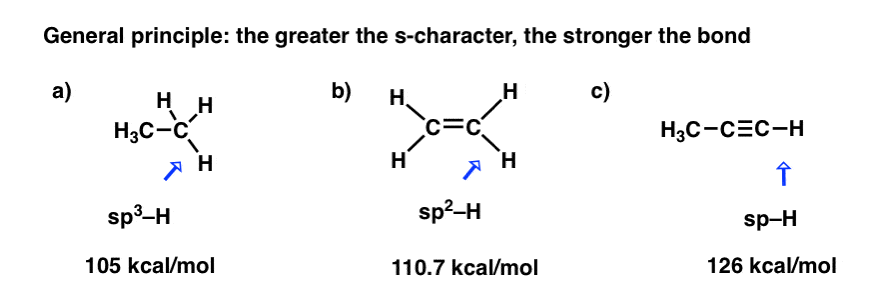
Note that the trend for bond strengths, above, is sp > sp2 > sp3
In other words, the more s-character on carbon, the stronger the bond.
Let’s try this again. What about these three C–C bonds?
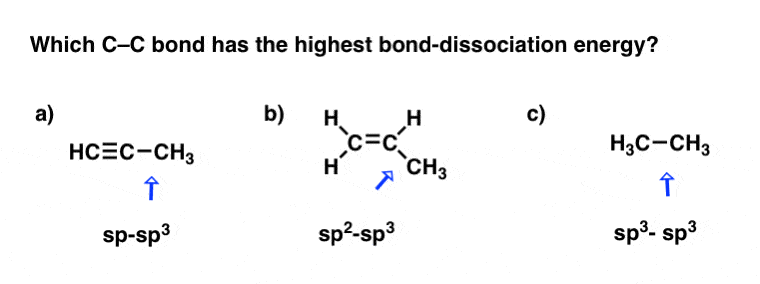
Hopefully you ranked them A > B > C .
All else being equal: an sp-sp3 bond is stronger than an sp2-sp3 bond, which in turn is stronger than an sp3-sp3 bond.
Why?
3. Electrons In s-Orbitals Are Closer To the Nucleus Than Electrons In The Corresponding p-Orbitals
On average: electrons in s orbitals are closer to the nucleus (and therefore feel a greater effective positive charge) than electrons in the corresponding p orbitals.
Electrons in an sp orbital (50% s-character) will therefore experience a greater attractive force to the nucleus than electrons in an sp2 (33% s-character) or sp3 (25% s-character) orbital.
“Bond dissociation energy” (BDE) mentioned above, is a measure of the energy required for homolytic cleavage of a bond (homo = same; lysis = breaking). [See post: Bond Dissociation Energies = Homolytic Cleavage]
That is, it measures the energy required for breakage of the bond such that each atom ends up with the same number of electrons, such as the reactions below:
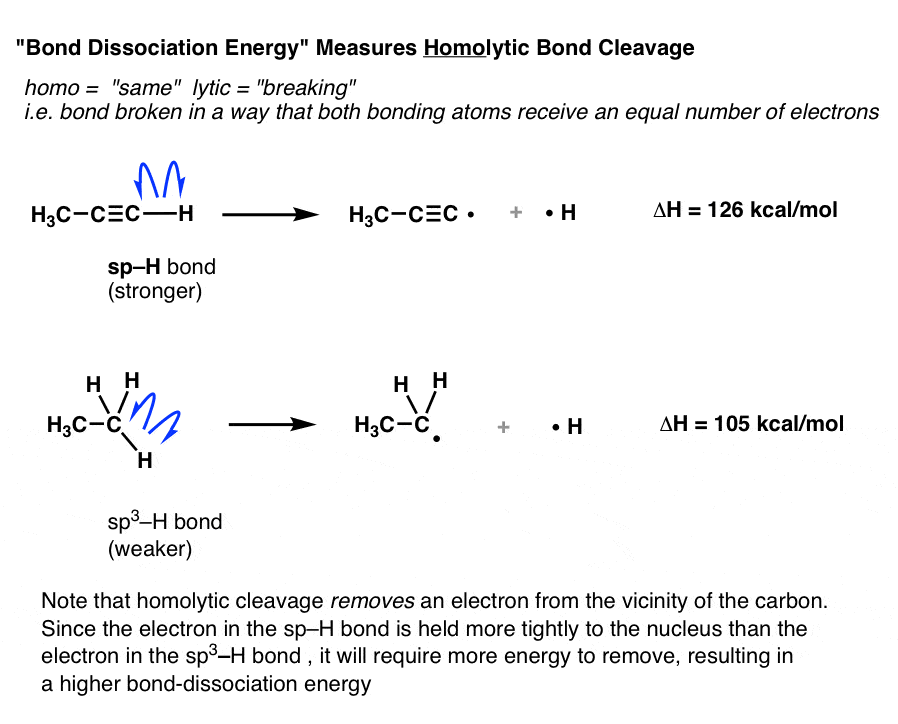
In the homolytic cleavage reactions above, a single electron is removed from the C–H molecular orbital and placed on hydrogen, which dissociates. The other electron remains on carbon.
The bond dissociation energy for the sp–H bond is higher than that for sp3–H because more force (energy) is required to remove an electron from the more tightly-held sp–H molecular orbital and place it exclusively on the hydrogen atom.
So electrons in an orbital with more s character will be closer to the nucleus and feel a stronger electrostatic force.
This helps to explain the higher bond energy.
Recognizing the type of bonds in molecules is a key skill. (see also: C-C sigma bonds come in six varieties, C-C pi bonds come in one).
For most purposes, this ends the key lesson of the post.
4. Summary: All Else Being Equal, The Greater The s-Character, The Stronger The Bond
But… if you find yourself trying to reconcile an apparent contradiction that comes from another part of the course, read on.
5. Bonus Section: An Answer To A Question A Few People Might Be Asking
Alkynes (pKa 25) are stronger acids than typical alkanes (pKa > 50).
For example, alkynes are readily deprotonated by strong bases such as NaNH2, whereas alkanes are not:
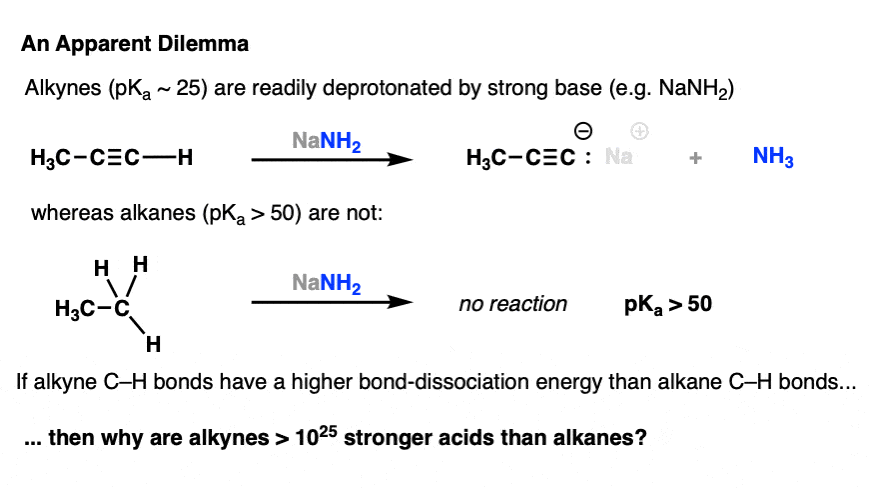
Why? Because the C–H bond in an alkyne has more s-character, and the resulting lone pair on carbon is held more tightly to the nucleus, rendering the conjugate base more stable.
Oh dear. There seems to be an angry mob approaching.
WAIT! You just said that alkyne C–H bonds are stronger than alkane C–H bonds because they have more s-character and now you are saying that they are easier to break because they have more s-character.
Shouldn’t that make alkynes less acidic because the C–H bonds have more s-character?

Put away the pitchforks! There is a perfectly logical explanation for this!
6. Homolytic versus Heterolytic Bond Cleavage
What’s the source of the confusion here?
Let’s follow the electrons.
Ultimately the resolution to this dilemma is recognizing the difference between homolytic cleavage (which is what bond dissociation energy measures) and heterolytic cleavage (which is what occurs in an acid-base reaction, the loss of H+ ).
Let’s look at these two processes.
In homolytic cleavage of a C–H bond, an electron is completely removed from the vicinity of the carbon and placed on hydrogen. Because of the greater s-character of the bond, it is more difficult to remove an electron from an sp-hybridized carbon than from an sp3 hybridized carbon. As we said above, that’s why the bond-dissociation energies for alkyne C–H bonds are higher than for alkane C–H bonds.
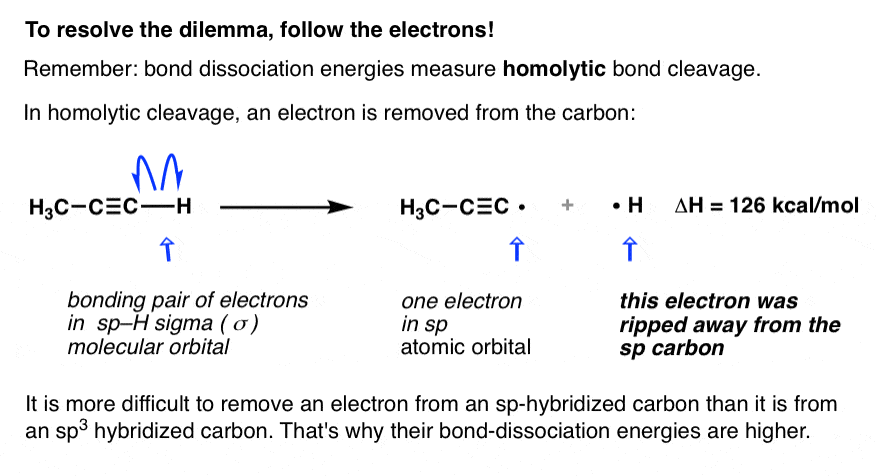 In an acid-base reaction, the C–H bond also breaks, but it breaks in such a way that the pair of electrons stays on the carbon atom. Since the bond breaks in a way that leads to an uneven distribution of electrons, it is called heterolytic bond cleavage (hetero = different, lysis = breaking).
In an acid-base reaction, the C–H bond also breaks, but it breaks in such a way that the pair of electrons stays on the carbon atom. Since the bond breaks in a way that leads to an uneven distribution of electrons, it is called heterolytic bond cleavage (hetero = different, lysis = breaking).
Let’s say that again: in an acid base reaction, the pair of electrons stays on carbon, resulting in a negatively-charged carbon atom (a “carbanion”).
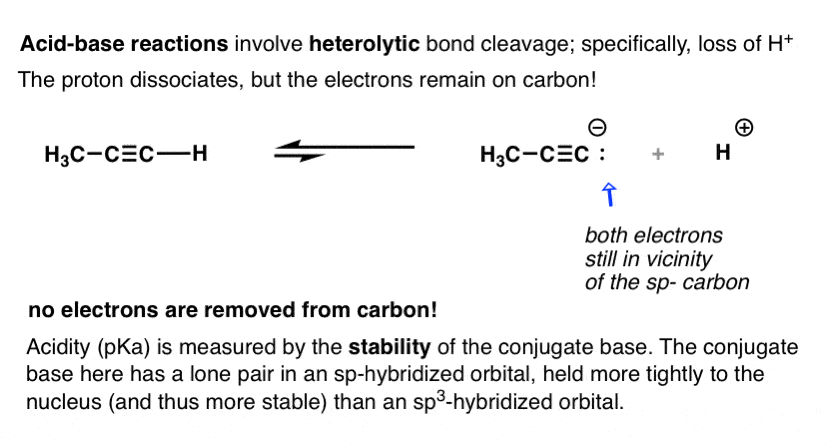
Acidity, as measured by pKa, is a measure of the equilibrium between an acid and its conjugate base. The more that the equilibrium favours the conjugate base, the lower the pKa and the stronger the acid. In other words:
Any factor which makes the conjugate base more stable, increases acidity.
- In the conjugate base of an alkyne, the lone pair is held in an sp- orbital with 50% s-character.
- In the conjugate base of an alkane, the lone pair is held in an sp3 orbital with 25% s-character.
What lone pair will be more stable?
The lone pair held more tightly to the nucleus – that is, the sp-orbital.
That’s why alkynes are more acidic than alkanes: the conjugate base is more stable.
Hopefully this makes it clearer that stronger C–H bonds and greater C–H acidity are two sides of the same phenomenon.
[You might find it helpful to think of sp orbitals as having a greater effective electronegativity than sp2 orbitals, which in turn have a greater electronegativity than sp3 orbitals. So the reason for the greater acidity of alkynes relative to alkenes is not really so different than the greater acidity of H–F relative to H2O. ]
7. A Test For You
At the risk of droning on, there is a third side of this phenomenon to consider.
Homolytic cleavage can only happen one way. But there are two ways to draw heterolytic cleavage of a C–H bond, and you might have noticed that I only showed one.
There’s a second (albeit unlikely) way heterolytic cleavage can happen. The pair of electrons in the C–H bond could migrate instead to hydrogen, not carbon, resulting in a hydride anion and a carbocation. [Again, very unlikely, but bear with me here].
Here’s a test I have for you. Based on everything we’ve gone through so far, which of the two products below (A or B) would be more stable?

Think it through.
- To form A, we have to remove a pair of electrons from an sp-hybridized carbon.
- To form B, we have to remove a pair of electrons from an sp3-hybridized carbon.
What’s more favourable?
- Reaction to give A would require removing two electrons from an sp-hybridized carbon.
- Reaction to give B would require removing two electrons from an sp3 hybridized carbon.
The reaction to give B should be much easier, because the electrons are less tightly held. And indeed, sp3-hybridized carbocations have been observed and even isolated.
In contrast, sp-hybridized carbocations such as A are extremely unstable and have never been observed directly. [Note 1]
This observation is also consistent with all the observations above!
8. One Last Thing: This Concept Also Explains Why CH3+ Is More Stable Than NH3+
As I said above, it can be helpful to think of sp-hybridized carbons as having a greater effective electronegativity than sp2-hybridized carbons, which in turn have greater electronegativity than sp3 hybridized carbons. We used this to rationalize why alkynes are stronger acids than alkanes, similarly to why H-F is a stronger acid than H2O.
This can also be flipped around, just as in our carbocation example above.
The greater the electronegativity of the atom, the more unstable electron-deficient species become.
This helps to explain why, for example, H3C+ (with six valence electrons) is much more stable than H3N+ (also with six valence electrons) which in turn is far more stable than oxygen or fluorine with six valence electrons; increasing electronegativity has the same effect on the stability of electron-deficient species as increasing s-character.
Notes
Related Articles
- Hybrid Orbitals and Hybridization
- How To Determine Hybridization: A Shortcut
- How Do We Know Methane (CH4) Is Tetrahedral?
- 7 Factors That Stabilize Positive Charge in Organic Chemistry
- 7 Factors that stabilize negative charge in organic chemistry
- 3 Factors That Stabilize Carbocations
- Bond Dissociation Energies = Homolytic Cleavage
- The Marriage May Be Bad, But the Divorce Still Costs Money
Note 1: Here’s a notable attempt to make sp-hybridized carbocations. The only application of helium in organic chemistry that I have ever seen.

00 General Chemistry Review
01 Bonding, Structure, and Resonance
- How Do We Know Methane (CH4) Is Tetrahedral?
- Hybrid Orbitals and Hybridization
- How To Determine Hybridization: A Shortcut
- Orbital Hybridization And Bond Strengths
- Sigma bonds come in six varieties: Pi bonds come in one
- A Key Skill: How to Calculate Formal Charge
- The Four Intermolecular Forces and How They Affect Boiling Points
- 3 Trends That Affect Boiling Points
- How To Use Electronegativity To Determine Electron Density (and why NOT to trust formal charge)
- Introduction to Resonance
- How To Use Curved Arrows To Interchange Resonance Forms
- Evaluating Resonance Forms (1) - The Rule of Least Charges
- How To Find The Best Resonance Structure By Applying Electronegativity
- Evaluating Resonance Structures With Negative Charges
- Evaluating Resonance Structures With Positive Charge
- Exploring Resonance: Pi-Donation
- Exploring Resonance: Pi-acceptors
- In Summary: Evaluating Resonance Structures
- Drawing Resonance Structures: 3 Common Mistakes To Avoid
- How to apply electronegativity and resonance to understand reactivity
- Bond Hybridization Practice
- Structure and Bonding Practice Quizzes
- Resonance Structures Practice
02 Acid Base Reactions
- Introduction to Acid-Base Reactions
- Acid Base Reactions In Organic Chemistry
- The Stronger The Acid, The Weaker The Conjugate Base
- Walkthrough of Acid-Base Reactions (3) - Acidity Trends
- Five Key Factors That Influence Acidity
- Acid-Base Reactions: Introducing Ka and pKa
- How to Use a pKa Table
- The pKa Table Is Your Friend
- A Handy Rule of Thumb for Acid-Base Reactions
- Acid Base Reactions Are Fast
- pKa Values Span 60 Orders Of Magnitude
- How Protonation and Deprotonation Affect Reactivity
- Acid Base Practice Problems
03 Alkanes and Nomenclature
- Meet the (Most Important) Functional Groups
- Condensed Formulas: Deciphering What the Brackets Mean
- Hidden Hydrogens, Hidden Lone Pairs, Hidden Counterions
- Don't Be Futyl, Learn The Butyls
- Primary, Secondary, Tertiary, Quaternary In Organic Chemistry
- Branching, and Its Affect On Melting and Boiling Points
- The Many, Many Ways of Drawing Butane
- Wedge And Dash Convention For Tetrahedral Carbon
- Common Mistakes in Organic Chemistry: Pentavalent Carbon
- Table of Functional Group Priorities for Nomenclature
- Summary Sheet - Alkane Nomenclature
- Organic Chemistry IUPAC Nomenclature Demystified With A Simple Puzzle Piece Approach
- Boiling Point Quizzes
- Organic Chemistry Nomenclature Quizzes
04 Conformations and Cycloalkanes
- Staggered vs Eclipsed Conformations of Ethane
- Conformational Isomers of Propane
- Newman Projection of Butane (and Gauche Conformation)
- Introduction to Cycloalkanes
- Geometric Isomers In Small Rings: Cis And Trans Cycloalkanes
- Calculation of Ring Strain In Cycloalkanes
- Cycloalkanes - Ring Strain In Cyclopropane And Cyclobutane
- Cyclohexane Conformations
- Cyclohexane Chair Conformation: An Aerial Tour
- How To Draw The Cyclohexane Chair Conformation
- The Cyclohexane Chair Flip
- The Cyclohexane Chair Flip - Energy Diagram
- Substituted Cyclohexanes - Axial vs Equatorial
- Ranking The Bulkiness Of Substituents On Cyclohexanes: "A-Values"
- Cyclohexane Chair Conformation Stability: Which One Is Lower Energy?
- Fused Rings - Cis-Decalin and Trans-Decalin
- Naming Bicyclic Compounds - Fused, Bridged, and Spiro
- Bredt's Rule (And Summary of Cycloalkanes)
- Newman Projection Practice
- Cycloalkanes Practice Problems
05 A Primer On Organic Reactions
- The Most Important Question To Ask When Learning a New Reaction
- Curved Arrows (for reactions)
- Nucleophiles and Electrophiles
- The Three Classes of Nucleophiles
- Nucleophilicity vs. Basicity
- What Makes A Good Nucleophile?
- What Makes A Good Leaving Group?
- 3 Factors That Stabilize Carbocations
- Equilibrium and Energy Relationships
- 7 Factors that stabilize negative charge in organic chemistry
- 7 Factors That Stabilize Positive Charge in Organic Chemistry
- What's a Transition State?
- Hammond's Postulate
- Learning Organic Chemistry Reactions: A Checklist (PDF)
- Introduction to Oxidative Cleavage Reactions
06 Free Radical Reactions
- Bond Dissociation Energies = Homolytic Cleavage
- Free Radical Reactions
- 3 Factors That Stabilize Free Radicals
- What Factors Destabilize Free Radicals?
- Bond Strengths And Radical Stability
- Free Radical Initiation: Why Is "Light" Or "Heat" Required?
- Initiation, Propagation, Termination
- Monochlorination Products Of Propane, Pentane, And Other Alkanes
- Selectivity In Free Radical Reactions
- Selectivity in Free Radical Reactions: Bromination vs. Chlorination
- Halogenation At Tiffany's
- Allylic Bromination
- Bonus Topic: Allylic Rearrangements
- In Summary: Free Radicals
- Synthesis (2) - Reactions of Alkanes
- Free Radicals Practice Quizzes
07 Stereochemistry and Chirality
- Types of Isomers: Constitutional Isomers, Stereoisomers, Enantiomers, and Diastereomers
- How To Draw The Enantiomer Of A Chiral Molecule
- How To Draw A Bond Rotation
- Introduction to Assigning (R) and (S): The Cahn-Ingold-Prelog Rules
- Assigning Cahn-Ingold-Prelog (CIP) Priorities (2) - The Method of Dots
- Enantiomers vs Diastereomers vs The Same? Two Methods For Solving Problems
- Assigning R/S To Newman Projections (And Converting Newman To Line Diagrams)
- How To Determine R and S Configurations On A Fischer Projection
- The Meso Trap
- Optical Rotation, Optical Activity, and Specific Rotation
- Optical Purity and Enantiomeric Excess
- What's a Racemic Mixture?
- Chiral Allenes And Chiral Axes
- Stereochemistry Practice Problems and Quizzes
08 Substitution Reactions
- Nucleophilic Substitution Reactions - Introduction
- Two Types of Nucleophilic Substitution Reactions
- The SN2 Mechanism
- Why the SN2 Reaction Is Powerful
- The SN1 Mechanism
- The Conjugate Acid Is A Better Leaving Group
- Comparing the SN1 and SN2 Reactions
- Polar Protic? Polar Aprotic? Nonpolar? All About Solvents
- Steric Hindrance is Like a Fat Goalie
- Common Blind Spot: Intramolecular Reactions
- Substitution Practice - SN1
- Substitution Practice - SN2
09 Elimination Reactions
- Elimination Reactions (1): Introduction And The Key Pattern
- Elimination Reactions (2): The Zaitsev Rule
- Elimination Reactions Are Favored By Heat
- Two Elimination Reaction Patterns
- The E1 Reaction
- The E2 Mechanism
- E1 vs E2: Comparing the E1 and E2 Reactions
- Antiperiplanar Relationships: The E2 Reaction and Cyclohexane Rings
- Bulky Bases in Elimination Reactions
- Comparing the E1 vs SN1 Reactions
- Elimination (E1) Reactions With Rearrangements
- E1cB - Elimination (Unimolecular) Conjugate Base
- Elimination (E1) Practice Problems And Solutions
- Elimination (E2) Practice Problems and Solutions
10 Rearrangements
11 SN1/SN2/E1/E2 Decision
- Identifying Where Substitution and Elimination Reactions Happen
- Deciding SN1/SN2/E1/E2 (1) - The Substrate
- Deciding SN1/SN2/E1/E2 (2) - The Nucleophile/Base
- SN1 vs E1 and SN2 vs E2 : The Temperature
- Deciding SN1/SN2/E1/E2 - The Solvent
- Wrapup: The Key Factors For Determining SN1/SN2/E1/E2
- Alkyl Halide Reaction Map And Summary
- SN1 SN2 E1 E2 Practice Problems
12 Alkene Reactions
- E and Z Notation For Alkenes (+ Cis/Trans)
- Alkene Stability
- Alkene Addition Reactions: "Regioselectivity" and "Stereoselectivity" (Syn/Anti)
- Stereoselective and Stereospecific Reactions
- Hydrohalogenation of Alkenes and Markovnikov's Rule
- Hydration of Alkenes With Aqueous Acid
- Rearrangements in Alkene Addition Reactions
- Halogenation of Alkenes and Halohydrin Formation
- Oxymercuration Demercuration of Alkenes
- Hydroboration Oxidation of Alkenes
- m-CPBA (meta-chloroperoxybenzoic acid)
- OsO4 (Osmium Tetroxide) for Dihydroxylation of Alkenes
- Palladium on Carbon (Pd/C) for Catalytic Hydrogenation of Alkenes
- Cyclopropanation of Alkenes
- A Fourth Alkene Addition Pattern - Free Radical Addition
- Alkene Reactions: Ozonolysis
- Summary: Three Key Families Of Alkene Reaction Mechanisms
- Synthesis (4) - Alkene Reaction Map, Including Alkyl Halide Reactions
- Alkene Reactions Practice Problems
13 Alkyne Reactions
- Acetylides from Alkynes, And Substitution Reactions of Acetylides
- Partial Reduction of Alkynes With Lindlar's Catalyst
- Partial Reduction of Alkynes With Na/NH3 To Obtain Trans Alkenes
- Alkyne Hydroboration With "R2BH"
- Hydration and Oxymercuration of Alkynes
- Hydrohalogenation of Alkynes
- Alkyne Halogenation: Bromination and Chlorination of Alkynes
- Alkyne Reactions - The "Concerted" Pathway
- Alkenes To Alkynes Via Halogenation And Elimination Reactions
- Alkynes Are A Blank Canvas
- Synthesis (5) - Reactions of Alkynes
- Alkyne Reactions Practice Problems With Answers
14 Alcohols, Epoxides and Ethers
- Alcohols - Nomenclature and Properties
- Alcohols Can Act As Acids Or Bases (And Why It Matters)
- Alcohols - Acidity and Basicity
- The Williamson Ether Synthesis
- Ethers From Alkenes, Tertiary Alkyl Halides and Alkoxymercuration
- Alcohols To Ethers via Acid Catalysis
- Cleavage Of Ethers With Acid
- Epoxides - The Outlier Of The Ether Family
- Opening of Epoxides With Acid
- Epoxide Ring Opening With Base
- Making Alkyl Halides From Alcohols
- Tosylates And Mesylates
- PBr3 and SOCl2
- Elimination Reactions of Alcohols
- Elimination of Alcohols To Alkenes With POCl3
- Alcohol Oxidation: "Strong" and "Weak" Oxidants
- Demystifying The Mechanisms of Alcohol Oxidations
- Protecting Groups For Alcohols
- Thiols And Thioethers
- Calculating the oxidation state of a carbon
- Oxidation and Reduction in Organic Chemistry
- Oxidation Ladders
- SOCl2 Mechanism For Alcohols To Alkyl Halides: SN2 versus SNi
- Alcohol Reactions Roadmap (PDF)
- Alcohol Reaction Practice Problems
- Epoxide Reaction Quizzes
- Oxidation and Reduction Practice Quizzes
15 Organometallics
- What's An Organometallic?
- Formation of Grignard and Organolithium Reagents
- Organometallics Are Strong Bases
- Reactions of Grignard Reagents
- Protecting Groups In Grignard Reactions
- Synthesis Problems Involving Grignard Reagents
- Grignard Reactions And Synthesis (2)
- Organocuprates (Gilman Reagents): How They're Made
- Gilman Reagents (Organocuprates): What They're Used For
- The Heck, Suzuki, and Olefin Metathesis Reactions (And Why They Don't Belong In Most Introductory Organic Chemistry Courses)
- Reaction Map: Reactions of Organometallics
- Grignard Practice Problems
16 Spectroscopy
- Degrees of Unsaturation (or IHD, Index of Hydrogen Deficiency)
- Conjugation And Color (+ How Bleach Works)
- Introduction To UV-Vis Spectroscopy
- UV-Vis Spectroscopy: Absorbance of Carbonyls
- UV-Vis Spectroscopy: Practice Questions
- Bond Vibrations, Infrared Spectroscopy, and the "Ball and Spring" Model
- Infrared Spectroscopy: A Quick Primer On Interpreting Spectra
- IR Spectroscopy: 4 Practice Problems
- 1H NMR: How Many Signals?
- Homotopic, Enantiotopic, Diastereotopic
- Diastereotopic Protons in 1H NMR Spectroscopy: Examples
- 13-C NMR - How Many Signals
- Liquid Gold: Pheromones In Doe Urine
- Natural Product Isolation (1) - Extraction
- Natural Product Isolation (2) - Purification Techniques, An Overview
- Structure Determination Case Study: Deer Tarsal Gland Pheromone
17 Dienes and MO Theory
- What To Expect In Organic Chemistry 2
- Are these molecules conjugated?
- Conjugation And Resonance In Organic Chemistry
- Bonding And Antibonding Pi Orbitals
- Molecular Orbitals of The Allyl Cation, Allyl Radical, and Allyl Anion
- Pi Molecular Orbitals of Butadiene
- Reactions of Dienes: 1,2 and 1,4 Addition
- Thermodynamic and Kinetic Products
- More On 1,2 and 1,4 Additions To Dienes
- s-cis and s-trans
- The Diels-Alder Reaction
- Cyclic Dienes and Dienophiles in the Diels-Alder Reaction
- Stereochemistry of the Diels-Alder Reaction
- Exo vs Endo Products In The Diels Alder: How To Tell Them Apart
- HOMO and LUMO In the Diels Alder Reaction
- Why Are Endo vs Exo Products Favored in the Diels-Alder Reaction?
- Diels-Alder Reaction: Kinetic and Thermodynamic Control
- The Retro Diels-Alder Reaction
- The Intramolecular Diels Alder Reaction
- Regiochemistry In The Diels-Alder Reaction
- The Cope and Claisen Rearrangements
- Electrocyclic Reactions
- Electrocyclic Ring Opening And Closure (2) - Six (or Eight) Pi Electrons
- Diels Alder Practice Problems
- Molecular Orbital Theory Practice
18 Aromaticity
- Introduction To Aromaticity
- Rules For Aromaticity
- Huckel's Rule: What Does 4n+2 Mean?
- Aromatic, Non-Aromatic, or Antiaromatic? Some Practice Problems
- Antiaromatic Compounds and Antiaromaticity
- The Pi Molecular Orbitals of Benzene
- The Pi Molecular Orbitals of Cyclobutadiene
- Frost Circles
- Aromaticity Practice Quizzes
19 Reactions of Aromatic Molecules
- Electrophilic Aromatic Substitution: Introduction
- Activating and Deactivating Groups In Electrophilic Aromatic Substitution
- Electrophilic Aromatic Substitution - The Mechanism
- Ortho-, Para- and Meta- Directors in Electrophilic Aromatic Substitution
- Understanding Ortho, Para, and Meta Directors
- Why are halogens ortho- para- directors?
- Disubstituted Benzenes: The Strongest Electron-Donor "Wins"
- Electrophilic Aromatic Substitutions (1) - Halogenation of Benzene
- Electrophilic Aromatic Substitutions (2) - Nitration and Sulfonation
- EAS Reactions (3) - Friedel-Crafts Acylation and Friedel-Crafts Alkylation
- Intramolecular Friedel-Crafts Reactions
- Nucleophilic Aromatic Substitution (NAS)
- Nucleophilic Aromatic Substitution (2) - The Benzyne Mechanism
- Reactions on the "Benzylic" Carbon: Bromination And Oxidation
- The Wolff-Kishner, Clemmensen, And Other Carbonyl Reductions
- More Reactions on the Aromatic Sidechain: Reduction of Nitro Groups and the Baeyer Villiger
- Aromatic Synthesis (1) - "Order Of Operations"
- Synthesis of Benzene Derivatives (2) - Polarity Reversal
- Aromatic Synthesis (3) - Sulfonyl Blocking Groups
- Birch Reduction
- Synthesis (7): Reaction Map of Benzene and Related Aromatic Compounds
- Aromatic Reactions and Synthesis Practice
- Electrophilic Aromatic Substitution Practice Problems
20 Aldehydes and Ketones
- What's The Alpha Carbon In Carbonyl Compounds?
- Nucleophilic Addition To Carbonyls
- Aldehydes and Ketones: 14 Reactions With The Same Mechanism
- Sodium Borohydride (NaBH4) Reduction of Aldehydes and Ketones
- Grignard Reagents For Addition To Aldehydes and Ketones
- Wittig Reaction
- Hydrates, Hemiacetals, and Acetals
- Imines - Properties, Formation, Reactions, and Mechanisms
- All About Enamines
- Breaking Down Carbonyl Reaction Mechanisms: Reactions of Anionic Nucleophiles (Part 2)
- Aldehydes Ketones Reaction Practice
21 Carboxylic Acid Derivatives
- Nucleophilic Acyl Substitution (With Negatively Charged Nucleophiles)
- Addition-Elimination Mechanisms With Neutral Nucleophiles (Including Acid Catalysis)
- Basic Hydrolysis of Esters - Saponification
- Transesterification
- Proton Transfer
- Fischer Esterification - Carboxylic Acid to Ester Under Acidic Conditions
- Lithium Aluminum Hydride (LiAlH4) For Reduction of Carboxylic Acid Derivatives
- LiAlH[Ot-Bu]3 For The Reduction of Acid Halides To Aldehydes
- Di-isobutyl Aluminum Hydride (DIBAL) For The Partial Reduction of Esters and Nitriles
- Amide Hydrolysis
- Thionyl Chloride (SOCl2) And Conversion of Carboxylic Acids to Acid Halides
- Diazomethane (CH2N2)
- Carbonyl Chemistry: Learn Six Mechanisms For the Price Of One
- Making Music With Mechanisms (PADPED)
- Carboxylic Acid Derivatives Practice Questions
22 Enols and Enolates
- Keto-Enol Tautomerism
- Enolates - Formation, Stability, and Simple Reactions
- Kinetic Versus Thermodynamic Enolates
- Aldol Addition and Condensation Reactions
- Reactions of Enols - Acid-Catalyzed Aldol, Halogenation, and Mannich Reactions
- Claisen Condensation and Dieckmann Condensation
- Decarboxylation
- The Malonic Ester and Acetoacetic Ester Synthesis
- The Michael Addition Reaction and Conjugate Addition
- The Robinson Annulation
- Haloform Reaction
- The Hell–Volhard–Zelinsky Reaction
- Enols and Enolates Practice Quizzes
23 Amines
- The Amide Functional Group: Properties, Synthesis, and Nomenclature
- Basicity of Amines And pKaH
- 5 Key Basicity Trends of Amines
- The Mesomeric Effect And Aromatic Amines
- Nucleophilicity of Amines
- Alkylation of Amines (Sucks!)
- Reductive Amination
- The Gabriel Synthesis
- Some Reactions of Azides
- The Hofmann Elimination
- The Hofmann and Curtius Rearrangements
- The Cope Elimination
- Protecting Groups for Amines - Carbamates
- The Strecker Synthesis of Amino Acids
- Introduction to Peptide Synthesis
- Reactions of Diazonium Salts: Sandmeyer and Related Reactions
- Amine Practice Questions
24 Carbohydrates
- D and L Notation For Sugars
- Pyranoses and Furanoses: Ring-Chain Tautomerism In Sugars
- What is Mutarotation?
- Reducing Sugars
- The Big Damn Post Of Carbohydrate-Related Chemistry Definitions
- The Haworth Projection
- Converting a Fischer Projection To A Haworth (And Vice Versa)
- Reactions of Sugars: Glycosylation and Protection
- The Ruff Degradation and Kiliani-Fischer Synthesis
- Isoelectric Points of Amino Acids (and How To Calculate Them)
- Carbohydrates Practice
- Amino Acid Quizzes
25 Fun and Miscellaneous
- A Gallery of Some Interesting Molecules From Nature
- Screw Organic Chemistry, I'm Just Going To Write About Cats
- On Cats, Part 1: Conformations and Configurations
- On Cats, Part 2: Cat Line Diagrams
- On Cats, Part 4: Enantiocats
- On Cats, Part 6: Stereocenters
- Organic Chemistry Is Shit
- The Organic Chemistry Behind "The Pill"
- Maybe they should call them, "Formal Wins" ?
- Why Do Organic Chemists Use Kilocalories?
- The Principle of Least Effort
- Organic Chemistry GIFS - Resonance Forms
- Reproducibility In Organic Chemistry
- What Holds The Nucleus Together?
- How Reactions Are Like Music
- Organic Chemistry and the New MCAT
26 Organic Chemistry Tips and Tricks
- Common Mistakes: Formal Charges Can Mislead
- Partial Charges Give Clues About Electron Flow
- Draw The Ugly Version First
- Organic Chemistry Study Tips: Learn the Trends
- The 8 Types of Arrows In Organic Chemistry, Explained
- Top 10 Skills To Master Before An Organic Chemistry 2 Final
- Common Mistakes with Carbonyls: Carboxylic Acids... Are Acids!
- Planning Organic Synthesis With "Reaction Maps"
- Alkene Addition Pattern #1: The "Carbocation Pathway"
- Alkene Addition Pattern #2: The "Three-Membered Ring" Pathway
- Alkene Addition Pattern #3: The "Concerted" Pathway
- Number Your Carbons!
- The 4 Major Classes of Reactions in Org 1
- How (and why) electrons flow
- Grossman's Rule
- Three Exam Tips
- A 3-Step Method For Thinking Through Synthesis Problems
- Putting It Together
- Putting Diels-Alder Products in Perspective
- The Ups and Downs of Cyclohexanes
- The Most Annoying Exceptions in Org 1 (Part 1)
- The Most Annoying Exceptions in Org 1 (Part 2)
- The Marriage May Be Bad, But the Divorce Still Costs Money
- 9 Nomenclature Conventions To Know
- Nucleophile attacks Electrophile
27 Case Studies of Successful O-Chem Students
- Success Stories: How Corina Got The The "Hard" Professor - And Got An A+ Anyway
- How Helena Aced Organic Chemistry
- From a "Drop" To B+ in Org 2 – How A Hard Working Student Turned It Around
- How Serge Aced Organic Chemistry
- Success Stories: How Zach Aced Organic Chemistry 1
- Success Stories: How Kari Went From C– to B+
- How Esther Bounced Back From a "C" To Get A's In Organic Chemistry 1 And 2
- How Tyrell Got The Highest Grade In Her Organic Chemistry Course
- This Is Why Students Use Flashcards
- Success Stories: How Stu Aced Organic Chemistry
- How John Pulled Up His Organic Chemistry Exam Grades
- Success Stories: How Nathan Aced Organic Chemistry (Without It Taking Over His Life)
- How Chris Aced Org 1 and Org 2
- Interview: How Jay Got an A+ In Organic Chemistry
- How to Do Well in Organic Chemistry: One Student's Advice
- "America's Top TA" Shares His Secrets For Teaching O-Chem
- "Organic Chemistry Is Like..." - A Few Metaphors
- How To Do Well In Organic Chemistry: Advice From A Tutor
- Guest post: "I went from being afraid of tests to actually looking forward to them".
Thank you. I would also like to say this is a great website.. I really liked the explanations and the dash of humour in between :)
How did the sp3 hybridization of C in CH3Cl change to sp2 hybridization in CH3+ obtained after heterolytic cleavage?
CH3Cl –> CH3+ + Cl-
How is there suddenly an unhybridised p orbital present on C of CH3+ (perpendicular to the molecular plane) and the C-H bond angles are 120°.
Did C-H bonds break when sp3 hybridization changed to sp2?
No C-H bonds broke. The C-Cl bond broke. The unhybridized p orbital used to be the sp3-hybridized C-Cl bond.
Imagine bonds as being tiny springs that attach atoms together – the C-Cl bond is always vibrating back and forth. Then imagine a vibration where the C-Cl bond becomes so long that the Cl- is able to break free, leaving with a pair of electrons. An empty orbital will remain, and the three filled C-H sp3 bonding pairs will adopt a geometry where they are slightly further apart (120°)
is hybridisation limited to carbon only?
No – nitrogen, oxygen, sulfur, other atoms exhibit orbital hybridization
In part 7 you asked which product was most stable but your discussion dealt with the reaction and every point you made was sensible. The sp3 orbital in the (B) reaction would lend itself to a more favorable reaction in comparison to the sp orbital in the (A) reaction. My problem is, and maybe I’m overthinking this from a lot of experience with phenyl ethynyl endcaps and fluorinated cyclic olefins, wouldn’t the electron rich triple bond tend to lend electrons across the molecule to de-localize the carbocation thus making the methylacetylene product more stable. Victor made a good point about how messing with triple bonds can lead to quick reactions/polymerizations. I know the answer wouldn’t be as troublesome with just acetylene but in my addled mind the methyl group muddies up the result. Or I’m throwing arrows around willy-nilly like I did decades ago in school. Also, this site is amazing.
thank you it is good post
can I use bond dissociation energy and bond energy interachegeablly ?
Yes, that is correct.
which sigma bond is strongest
A – s_s overlap
B – s-p overlap
C – p-p overlap
Jim, I tried posting a comment twice. I carefully copy and paste and read it in this box just to check it is OK. But each time some of my comment gets deleted after it is sent and it reads horrible. Ugh! Why?!? Third time lucky (probably not)
Jim,
First, thank you for your excellent posts (and figures!) which clarify so many points.
My question concerns the second part of your post. I have no trouble understanding that in an acid/base reaction an electron pair would prefer to sit in an orbital with more s character rather than one with more p.
But I guess my question is when you say think of alkane/alkyne acid base properties as similar to electronegativity across a row, the alternative might be to think of going up a column, where smaller, more electronegative atoms are worse acids (HF<< HCl < HBr < HI).
So wouldn't a C-H bond with more s character also stabilize the bond better? Consistent with this C-H bonds do decrease slightly in length from alkanes to alkynes.
Now obviously the experimental numbers support your way of thinking… but is there any chemical intuition you would use to explain why one should immediately think of this as going across a row rather than up a column?
The best I can come up with is, well the changes in size here are very modest as you move from alkanes to alkynes and more in line with going across a row, i.e. from carbon to fluorine covalent radii go: 84 pm to 57 pm, a difference of only 50%, while going up a column, iodine to fluorine size goes from 139 to 57 pm, a 144% difference (and the shell number changes).
Is there any other intuition you might offer of why electronegativity defeats the column size argument here?
Sorry for the length… and again… thank you for your wonderful site.
Regards,
George
Thank you sir for the above explanation.
But don’t we compare the bond strength based on overlap extent of orbitals. As my book remarks, the relative strength of bond resulting from a p-p overlap is greater than s-s overlap due to greater extent of overlapping in p-p orbital.
And according to this logic can we say that a sp2-s overlap will be greater than a sp-s overlap thus resulting in higher bond energy of C-H bond in alkenes as compared to that in alkynes ( believing that an orbital with greater p character has a better overlap).
Can u plz clear this confusion…
I am using, “bond dissociation energies” interchangeably with “bond strengths” here. Comparing bond dissociation energies leads to the conclusion that bond strength increases as p-orbital character decreases.
What book are you using that states p-p orbital overlap as being more favorable than s-s ? If you look in the carbon series (alkane alkene alkyne) the progression is clear.
Be aware that in O-O and N-N it may appear that pi-bonds are stronger but this is an artefact from the relief of lone pair repulsion.
Hello, as far as the s-character goes, should sp = 50% s-character, sp^2 = 33.3% s-character and sp^3 = 25% s-character? You said sp has the greatest s character so the other hybridizations should be lower in s-character.
Fixed the typo. Thanks!!!!
Nice post, James, quite as usual. Spent a couple of years of my life putting EWG’s (like F, boranes, and CF3) on the terminal acetylenes to make them more reactive. Half of the time, the product would polymerize or do something else before I could snap-freeze it with liq. nitrogen.
On a side note, you’re missing the Note 2. So, I had to note that your note 2 is, in fact, note 1. Pun intended ;)
Thank you – note 1 was expunged, since I managed to cover it in the text.